#ato 12-nichi
Text

today is dissidia end of service and i'll miss you so much so i've been drawing you everyday with my sonaーーーーーfinal entry:

7 notes
·
View notes
Text
Golden best [CD]
New item:

Shelf: 767.8 YOS (@ CD section)
Golden best. Words & melodies
by Yoshida Takurō.
Tokyo : Sony Music Direct (Japan), 2011.
2 CDs : digital, stereo ; 12 cm. + 1 libretto (32 pages).
Sung music in Japanese.
Track list:
[disc 1]
Asu ni mukatte hashire
Senkō hanabi
Genki desu
Kōkishin '73
Kotoba
Tabi no yado
Kayōkyoku
Bītoruzu ga oshietekureta
Kurashi
Kin'yōbi no asa
Natsuyasumi
Shinshia
Tadorituitara itsumo amefuri
Okizari ni shita kanashimi wa
Ma ni au kamo shirenai
Erimo misaki
Hirahira
Kuchibiru o kamishimete
Rakuyō
Ningen nante
Imēji no uta.
[disc 2]
Haru datta ne '73
Māku II '73
Tomodachi
Ryūsei
Chishiki
Kagawa Ryō no tegami
Otogi sōshi
Dōshite konna ni kanashiindarō
Tsuma no aki
Oyaji no uta
Okurimono
Kekkonshiyō yo
Kaze
Tonari no machi no ojōsan
Matsuri no ato
Seifuku
Soto wa shiroi yuki no yoru
7-gatsu 26-nichi mimei
Jinsei o katarazu
Kyō made soshite ashita kara
3 notes
·
View notes
Text
Nampō Roku, Book 2 (12): (1587) Twelfth Month, Eleventh Day, After the Morning Meal.

12) Twelfth Month, Eleventh Day¹; following the morning meal, fu-ji [不時]².
◦ Three-mat room³.
◦ (Guests:) Toda minbu [戸田民部]⁴, Ikeda Bicchū [池田備中]⁵.
First⁶:
﹆ One bowl of usucha was served⁷.
◦ Mizusashi Bizen [水指 備前]⁸;
◦ nakatsugi [中次]⁹.
▵ Kobu aburite ・ kuri [コフ アフリテ ・ 栗]¹⁰.
◦ [Then,] using the na-kago [菜籠], a full-set of charcoal was laid [in the ro]¹¹.
◦ Kama unryū [釜 雲龍]¹².
◦ On the tana, the kōgō and habōki¹³.
◦ Toko Tōyo [床 東與]¹⁴ -- [it had been] hanging from the beginning¹⁵.
◦ After [the scroll in the] toko was rolled up¹⁶, in a take-zutsu [竹筒], plum [blossoms]¹⁷.
◦ Chaire Shiri-bukura [茶入 尻フクラ], on [its] tray¹⁸;
◦ temmoku [天目]¹⁹;
◦ mizusashi Bizen [水指 備前] -- [the same] as in the beginning²⁰.
_________________________
¹Jūni-gatsu jūichi-nichi [十二月十一日].
The Gregorian date for this chakai was January 19, 1587.
²Asa-han ato fu-ji [朝飯後 不時].
In other words, after taking the morning meal, it was spontaneously decided to have a chakai.
Both guests were numbered among Hideyoshi's personal guards, and had probably been on guard duty the night before -- after which they would have been served breakfast before being dismissed. It seems that the two decided to stop by Rikyū's residence for chanoyu on their way home.
³Sanjō shiki [三疊敷].
This entry is problematic. The “3-mat room” that is occasionally mentioned in his kaiki generally refers to Nambō Sōkei's Shū-un-an (illustrated below), which he seems to have borrowed when receiving certain guests in his own home would have proven inappropriate*.

That said, there is no indication that this gathering was held in Sakai -- and, indeed, it would have been difficult for the guests to “suddenly” visit Rikyū there after taking their morning meal elsewhere, if the chakai were held in Sakai (in addition to the distance between Ōsaka and Sakai, Japanese citizens -- and particularly important officials such as these -- could not freely enter Sakai on the spur of the moment).
While Shibayama Fugen's entry concurs with what is found in the Enkaku-ji copy of the text, Tanaka Senshō states that the room was a nijō shiki [二疊敷] -- which would mean the two-mat room in Rikyū's residence.

In fact, though Tanaka does not mention that his copy deviates from other versions† (as he usually does when any of the then-known texts vary from the others), given that this was a fu-ji no chakai [不時の茶會], the two-mat room in Rikyū's official residence within Hideyoshi's Ōsaka castle complex would be a more logical place for these two important warriors to visit on the spur of the moment.
The kaiki is rather disorganized, which suggests that it may not have been part of Rikyū's manuscript, but added (from other sources) by someone else at a later date.
__________
*A “three-mat room” is mentioned in some of the kaiki written by other people (such as Kamiya Sōtan), but the details are confusing -- for example, though the room is called a three mat room (with 5-shaku toko -- similar to the original Tai-an room), it seems that there was either a daime appended to the room, or else the maru-jō utensil mat was used like a daime (perhaps it had a sode-kabe at the end, like the original Tai-an). Since Tanaka Senshō's manuscript states that it was a 2-mat room, and in the absence of any clear details, it seems best to treat this as a 2-mat room -- since this “3-mat room” is only mentioned this once (all other references clearly refer to the Shū-un-an).
†Tanaka Senshō used a handmade copy of the text as his teihon [底本], which was copied much earlier than the text consulted by Shibayama Fugen.
It is possible that the reading of the Enkaku-ji text is unclear -- the document shows a certain amount of insect damage which might make a two (ni [二]) seem to be a three (san [三]). Unfortunately, circumstances now make it difficult for me to confirm this.
⁴Toda minbu [戸田民部].
This refers to the bushō [武将] Toda Katsutaka [戸田勝隆; ? ~ 1594], who was the Assistant Vice-minister of Public Affairs (minbu-no-sunaisuke [民部少輔], also pronounced minbu-no-shōyu).
Katsutaka had been a personal retainer of Hideyoshi's, serving in his mounted guard, and so was in a position of great trust (since he was permitted to appear armed in Hideyoshi's presence). He participated in many of Hideyoshi's campaigns, and was part of the committee that negotiated the truce that formalized the cessation of hostilities following the First Invasion of the Continent. However, he was taken ill on the return journey, and died before reaching his homeland.
Katsutaka was also one of Rikyū's personal disciples, and was one of the small group of men permitted to receive the gokushin teachings by Hideyoshi.
⁵Ikeda Bitchū [池田備中].
This was the daimyō Ikeda Nagayoshi [池田長吉; 1570 ~1614], who held the junior grade of the Fifth Rank as Governor of the province of Bitchū (Bitchū-no-kami [備中守]). He was also one of Hideyoshi's personal retainers, and had the distinction of having been adopted by Hideyoshi.
Nevertheless, at the battle of Sekigahara (1600), Nagayoshi supported the claims of Tokugawa Ieyasu, and was afterward rewarded with Tottori castle (Tottori-jō [鳥取城]), which remained in his family throughout the Edo period.
In the Rikyū Hyakkai Ki, Ikeda Nagayoshi appeared as a fellow guest together with Toda Katsutaka at a chakai that Rikyū gave for them on the 10th day of the First Month of Tenshō 19 (1591), also in the morning, suggesting that (on both this and the other occasion) they visited Rikyū on their way from Hideyoshi's residence.
⁶Ubu [初].
Though the kanji is the same, ubu [初] does not mean the shoza, as it does in most of the entries; it means “first” or “beginning” -- that is, that the service of usucha happened at the beginning of this fuji-no-chakai.
The scroll in the toko had been hung up at dawn, after the room was swept, at which time the fire would have been put into the ro, and a large kama (perhaps the Temmyō ko-arare uba-guchi gama [天命小霰姥口釜], below, that Rikyū used at his previous chakai) placed over it to heat -- despite the fact that nobody had been invited for chanoyu that day.
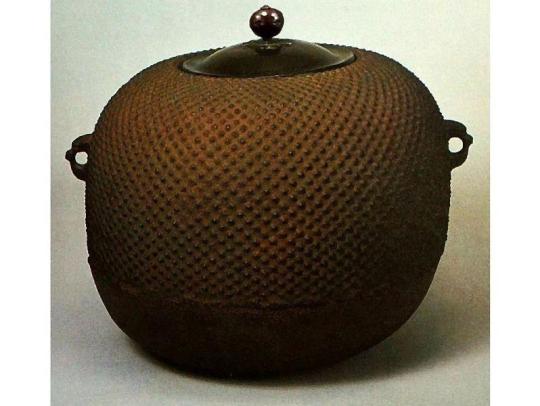
When the two men arrived, noticing that the kama from dawn was still boiling, Rikyū invited them into the small room for usucha (using some left-over matcha that he happened to have on hand), after which he removed the larger kama, rebuilt the fire (while simultaneously having some fresh matcha ground in the mizuya), and put the small unryū-gama, filled with fresh water, on to boil, so he could serve the guests especially delicious koicha.
Shibayama Fugen suggests that the temae at the beginning of the chakai, at which only one bowl of usucha was served*, was probably a hakobi-temae [運び手前], meaning that Rikyū brought the mizusashi, chawan and nakatsugi, and hishaku, futaoki, and koboshi, out from the katte, served tea, and then took these things away (perhaps without haiken)†.
Tanaka Senshō, furthermore, adds that the kōgō and habōki were displayed on the tana from the start, so that the kane-wari for the “shoza” was:
◦ toko: kakemono, han [半];
◦ room: kama, han [半];
◦ tana: kōgō and habōki, arranged side by side, chō [調].
Han + han + chō equals chō, which is appropriate to the shoza -- even though usucha was served.
__________
*Though modern-day conventions suggest a single large bowl of usucha was passed around for all to share, in Rikyū's day offering each guest an individual bowl of usucha would have been the usual way to do this.
†That said, this kind of temae was usually considered more appropriate to a 4.5-mat room, since in the smaller rooms, the host was supposed to keep his entrances and exits to a minimum. That is why the room had a built-in tana.
Nevertheless, the present chakai seems to provide an exception -- since there would be no way to display both the tea utensils and the kōgō and habōki at the same time while still adhering to the rules of kane-wari -- and good taste.
⁷Usucha ippuku [薄茶一服].
Probably each guest was served one bowl of usucha -- even though, according to the modern custom, zen-cha [前茶]* is usually served as sui-cha [吸い茶]†. Rikyū writes the word ippuku to indicate that the service of usucha was truncated -- rather than allowing the guests to drink as much as they wanted‡.
__________
*Zen-cha [前茶] means usucha served at the beginning of a chakai or chaji.
The reader must be careful not confuse this with Zen-cha [禪茶], which means Zen-tea (or Zen and tea).
†Sui-cha [吸い茶] means a single bowl of tea is shared by all the guests, being passed from hand to hand with each drinking a portion.
‡As is usual when usucha follows koicha -- in the ordinary case where usucha follows koicha, the limiting factor would be only how much matcha remains in the tea container.
⁸Mizusashi Bizen [水指 備前].
This seems to have been the same mizusashi that Rikyū used during the previous chakai.

⁹Nakatsugi [中次].
A nakatsugi* was a storage container, used to keep tea for several days (so it would not spoil, and could still be served as usucha).

This suggests that Rikyū was using tea that had been ground for a previous chakai to serve as usucha first -- while the matcha that he would serve as koicha was being ground in the mizuya.
Though nothing is said about the chawan, Rikyū may have used the same one that he mentions later in the kaiki -- apparently his Seto-temmoku [瀬戸天目], used without a dai.

As for the other things, Rikyū would have used an ori-tame [折撓] of the usual length†, as well as a take-wa [竹輪] and mentsū [面桶].
__________
*While Rikyū clearly states when he used the nakatsugi that was made for him by Tenka-ichi Seiami [天下一盛阿彌] (Hideyoshi's personal lacquer artisan), this nakatsugi would have been an ordinary storage container -- that period's equivalent of Tupperware.
†He probably changed the chashaku afterward for a smaller one, made to match the bon-chaire that he used when serving koicha during the latter part of the chakai.
¹⁰Kobu aburite ・ kuri [コフ アフリテ ・ 栗].
After serving his guests a bowl of usucha (essentially, to wash down their breakfasts -- which they had probably taken in Hideyoshi's residence), Rikyū offered them some light refreshments (to prepare them for the koicha that would be served later).
This consisted of toasted kelp and roasted chestnuts†.
__________
*Kobu [コフ = こぶ] is usually pronounced (and written) kombu [こんぶ = 昆布] today.
†Kuri [栗] is Rikyū's abbreviated way of writing yaki-guri [燒栗].
¹¹Na-kago ni te issumi [菜籠ニテ一炭].
This was Rikyū's na-kago sumi-tori [菜籠炭斗].

Issumi [一炭] means a full set of charcoal. Since the fire had been laid at dawn, while the guests had arrived after the morning meal (which was generally served in the middle of the morning), the charcoal would have mostly burned away by the time that Rikyū finished serving a bowl of usucha to each of the guests immediately after they arrived. Therefore, after taking the kama out to the mizuya*, he would have collected the embers together into the middle of the ro, and then laid a full set of charcoal around them.
After adding the incense to the ro, Rikyū would have returned to the katte and brought out his bamboo jizai (which he suspended from the hook attached to the ceiling), and then brought out the wet small unryū-gama, which he suspended over the ro†.
__________
*It would not be reused, since a large kama would take too long to return to a boil. Also, since the matcha was being ground freshly, pure water that had not been boiling in the kama too long would make for the best-tasting koicha. Thus, Rikyū substituted the small unryū-gama for the other, before the eyes of the guests, during the sumi-temae.
†Given its small size, the kama would begin to boil in around 15 minutes, so that after the sumi-temae, the guests would have gone out to the koshi-kake for the naka-dachi -- and to use the restroom -- and they would have been ready to return about the time that the kama began to boil.
¹²Kama unryū [釜 雲龍].
This was the second small unryū-gama [小雲龍釜], with matsu-gasa kan-tsuki [松笠鐶付] and a cast-iron lid.
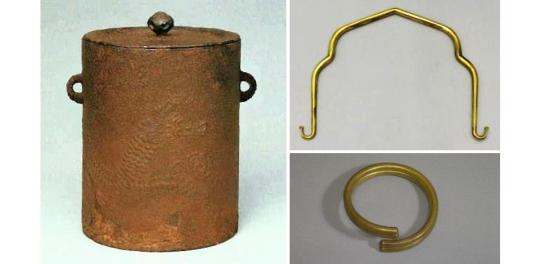
It was suspended over the ro on Rikyū's abura-dake jizai [油竹自在], using his bronze kan and tsuru.
¹³Tana ni kōgō ・ habōki [棚ニ 香合 ・ 羽帚].
The kōgō would have been Rikyū's ruri-suzume [瑠璃雀], which was the one that he ordinarily used with the ro.

And the habōki would have been a go-sun-hane, as appropriate to the small room, most likely made of shima-fukurō [嶋梟] feathers, as shown above.
¹⁴Toko Tōyo [床 東與].
This refers to a bokuseki written by the Yuan dynasty monk Dōnglíng Yǒng-yú [東陵永璵; 1285 ~ 1365]* (whose name is pronounced Tōryō Eiyo in Japanese).
He is said to have been related to the great Chán master Wúxué Zǔyuán [無學祖元; 1226年 ~ 1286] (Mugaku Sogen in Japanese). Both Wúxué and Dōnglíng emigrated to Japan in order to spread the orthodox Chán teachings.
Dōnglíng Yǒng-yú was a follower of the Sōtō sect [曹洞宗] of Chán; and, as mentioned above, he came to Japan in Shōhei 6 [正平六年] (1351). Although he was a monk of the Sōtō Shū, he served as the abbot (jūji [住持]) of a number of important Japanese temples that had no affiliation with that sect, among which were the Tenryū-ji [天龍寺] and Nanzen-ji [南禪寺] in Kyōto, and the Kenchō-ji [建長寺] and Enkaku-ji [圓覺寺] in Kamakura.

The kakemono in question was more likely the hōgo [法語] that is shown above.
___________
*When writing this abbreviated version of his name (it uses the first and last of the four kanji), Rikyū has mistaken the second kanji -- writing yo [與] (a kanji found in his own childhood name of Yoshirō [與四良]), rather than yo [璵].
According to this form, the name should have been written Tōyo [東璵].
¹⁵Hajime yori kakaru [初よりカヽル].
In other words, the scroll, while mentioned here, was actually hanging in the tokonoma when the guests entered the room.
This kaiki was set down in a very haphazard manner.
¹⁶Toko makite [床巻テ].
This is one of Rikyū's abbreviations, and means that the scroll was rolled up, and removed from the toko. (It does not mean, as Tanaka Sensho implies, that the rolled-up scroll was displayed on the floor of the toko*.)
__________
*Sometimes a scroll was arranged in this way, to display its gedai [外題] -- a sort of title (it usually included the name of the artist responsible for the scroll) that was written on a small slip of paper, which was glued to the back side of the scroll near the roller.
However, scrolls were displayed in this way first, and only after the guests had inspected the gedai was the scroll hung up so they could look at the honshi.
¹⁷Take-zutsu ni ume [竹筒ニ梅].
As discussed in the previous post, prior to the summer of 1590, the word take-zutsu [竹筒] referred to what is otherwise known as an oki-zutsu [置き筒], a length of bamboo that was stood on an usu-ita on the floor of the toko, for use as a hanaire.

Given the time of year, the plum blossoms were probably of the early-flowering pink variety.
This entry begins the list of the things displayed at the beginning of the goza. In terms of kane-wari:
◦ toko: chabana, han [半]*;
◦ room: kama, mizusashi (with the bon-chaire and temmoku placed, side by side, in front of it), chō [調];
◦ tana: nothing, making it chō [調].
Han + chō + chō equals han, which is appropriate to the goza.
__________
*As mentioned above, Tanaka Senshō, in his commentary on the kane-wari, inexplicably argues that the kakemono, after it was rolled up, was left in the toko (this interpretation of toko makite [床巻テ] actually goes against the way he has understood these words on previous occasions), with the chabana added to it (though where it may have been placed -- or perhaps he imagines that it was hung up on the hook? -- he does not venture to say). This throws the entire kane-wari scheme off; so that he then has to argue that the bon-chaire must be counted separately from the mizusashi in order for the total to be han [半].
This is what happens when one is playing with disembodied words, rather than approaching the matter with an understanding of what the utensils actually are.
¹⁸Chaire Shiri-bukura bon ni [茶入 尻フクラ 盆ニ].
The chaire that he named Shiri-bukura [尻膨]* was Rikyū's treasured karamono ko-tsubo chaire [唐物小壺茶入].
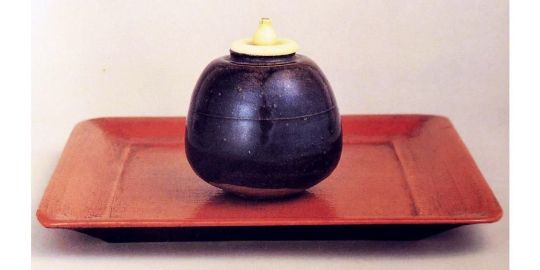
This chaire holds sufficient matcha to serve two, or possibly three, guests. It would have been filled with the just-ground matcha.
The tray is exactly 2-sun larger than the chaire on all fours sides. That means that the bon-chaire can be placed in front of the mizusashi and the chaire will be separated from it by 2-sun, just like a chaire without a tray. Consequently, with respect to kane-wari, the mizusashi and the things in front of it are counted together as a single unit (just as when an ordinary chaire is displayed in front of the mizusashi)†.
Furthermore, for the same reason, the temmoku-chawan (without a dai) could be displayed on the mat next to the bon-chaire while still adhering faithfully to the teachings of kane-wari‡.

And though not mentioned, Rikyū would have used a (different) ori-tame (chashaku), one that he had made to match this bon-chaire.
__________
*The name comes from its shape. The widest part of its circumference is at the hips, which is what the name means.
†This is true for all of the chaire that Rikyū paired with trays (though it is usually not true for trays paired with chaire by most other people of his generation, or before, or after).
‡When a chawan is placed next to the bon-chaire, the distance between the chawan and the chaire is also 2-sun, which is the same as when a tray is not present.
Unless these things are understood, it will be impossible to understand Rikyū’s usages -- or the way his arrangements conform to the teachings of kane-wari.
¹⁹Temmoku [天目].
While not described further, this was probably Rikyū's Seto-temmoku [瀬戸天目] shown below.

Since nothing is said (and, indeed, the fact that this was an impromptu chakai argues against it), the temmoku was probably displayed on the utensil mat (next to the bon-chaire) without its dai, with the chakin, chasen, and chashaku arranged in it as if it were an ordinary chawan.
Possibly the temmoku was also used at the beginning of the chakai, to serve usucha (since Rikyū disliked using any more utensils than absolutely necessary).
²⁰Mizusashi Bizen hatsu no [水指 備前 初ノ].
This means that the mizusashi was the same one that had been used when serving usucha at the beginning of the chakai. This, too, suggests that the chawan may also have been the same.
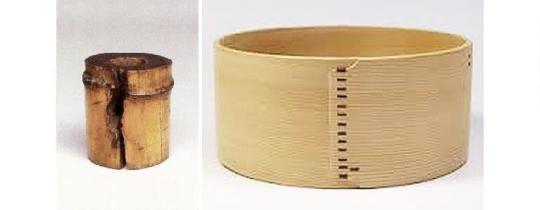
As for the futaoki and koboshi, these would have been a take-wa [竹輪] and a mentsū [面桶] -- the mentsū probably being a new one, rather than the one used during the service of usucha earlier.
0 notes
Text
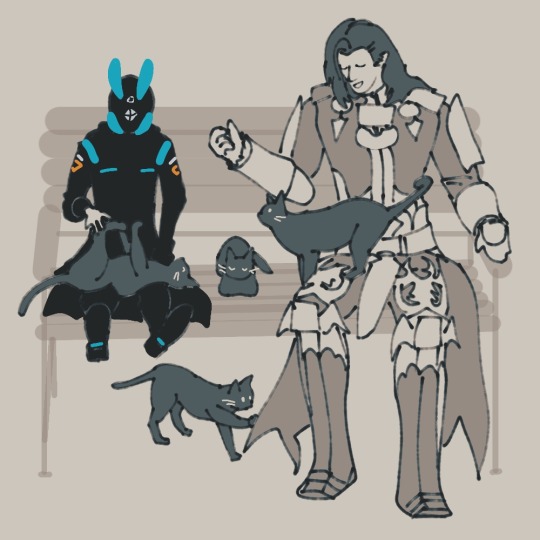
xii days until dissidia end of service and i'll miss you so much so i'll draw you everyday with my sonaーーーーーday 1: time together.
2 notes
·
View notes
Text
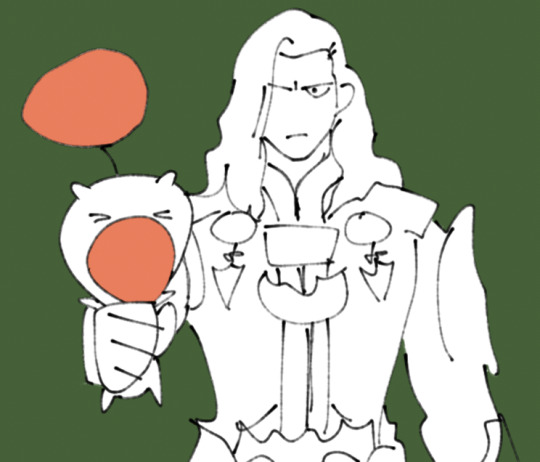

xii days until dissidia end of service and i'll miss you so much so i'll draw you everyday with my sonaーーーーーday 6: favorite scene (moogle abuse)
17 notes
·
View notes
Text
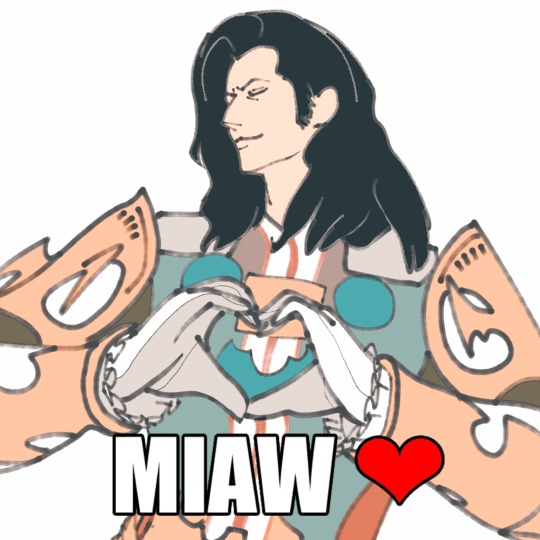
xii days until dissidia end of service and i'll miss you so much so i'll draw you everyday with my sonaーーーーーday 2: MIAW ♥️ meow. meow. meow.
9 notes
·
View notes
Text

xii days until dissidia end of service and i'll miss you so much so i'll draw you everyday with my sonaーーーーーday 5: you will Listen to me.
8 notes
·
View notes
Text

xii days until dissidia end of service and i'll miss you so much so i'll draw you everyday with my sonaーーーーーday 7: i planned to make a 4-koma with this pose as the punchline. but today i'm so tired and still have a lot of things to do. so im using a cheatday and so here's the two of them dying on a beach.
6 notes
·
View notes
Text

xii days until dissidia end of service and i'll miss you so much so i'll draw you everyday with my sonaーーーーーday 12: hot bath (stew) for tomorrow.
5 notes
·
View notes
Text
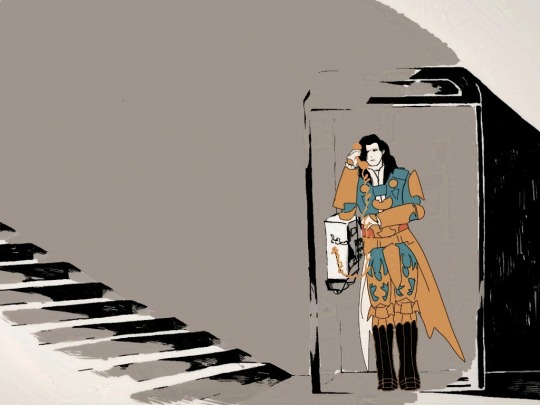
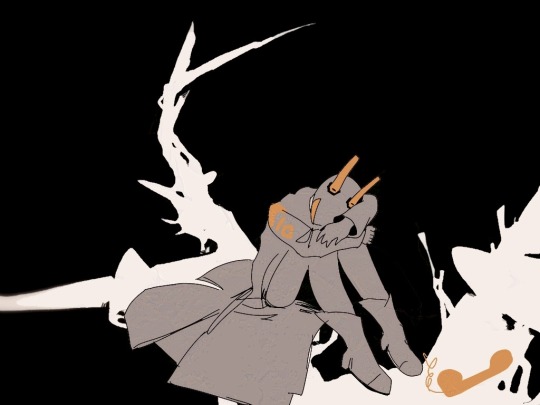
xii days until dissidia end of service and i'll miss you so much so i'll draw you everyday with my sonaーーーーーday 10: seigi mv (思い出して 終わらないで 抱きしめたいように)
6 notes
·
View notes
Text

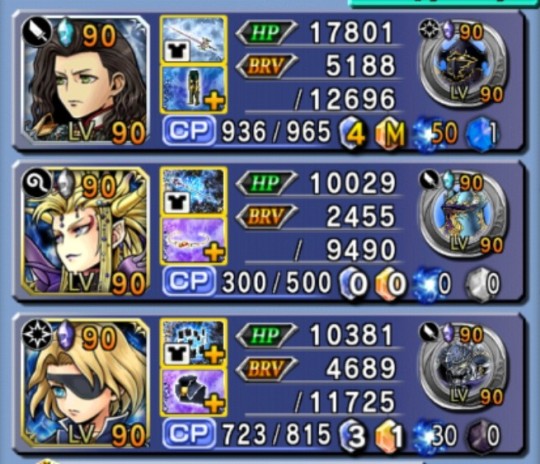
xii days until dissidia end of service and i'll miss you so much so i'll draw you everyday with my sonaーーーーーday 9: my team (the player is a villain enjoyer) (the player doesn't care about meta) (casual player spotted)
6 notes
·
View notes
Text

xii days until dissidia end of service and i'll miss you so much so i'll draw you everyday with my sonaーーーーーday 8: leave your game. stay with me
6 notes
·
View notes
Text

xii days until dissidia end of service and i'll miss you so much so i'll draw you everyday with my sonaーーーーーday 4: i remember hard pity-ing for your weapons pathetically.
i remember gacha-ing for his weapons pathetically. i was in a lecture, and there was me with my phone, 300 pulls in and no luck. my friend shrimp who sat next to me, watched me pull and pull pathetically. "are you alright?".
that was some years ago. vayne has always been the strongest character i have, i gave him all the buff and maxxed out the stats.
.....
when he shows up in another game, i'll be sure to pull for him pathetically again.
2 notes
·
View notes
Text

xii days until dissidia end of service and i'll miss you so much so i'll draw you everyday with my sonaーーーーーday 3: cinema.
2 notes
·
View notes
Text

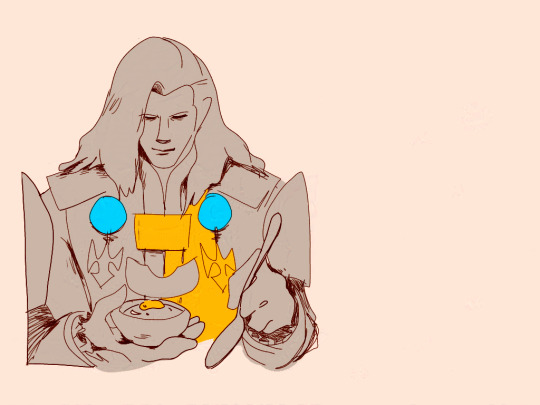
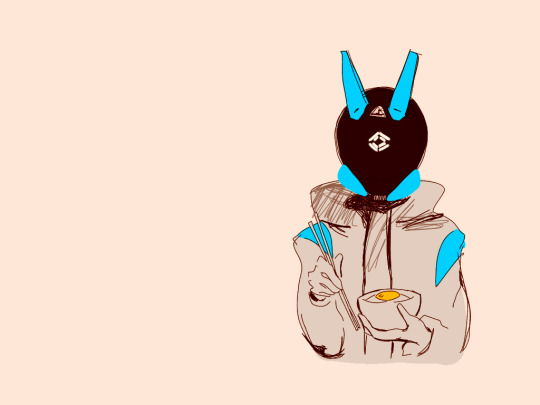
xii days until dissidia end of service and i'll miss you so much so i'll draw you everyday with my sonaーーーーーday 11: seigi 2
6 notes
·
View notes